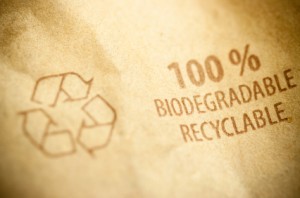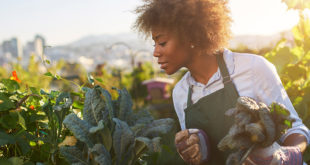Any restaurateur interested in making their restaurant more green has encountered these terms before. The problem is, just because a product claims it is compostable, biodegradable, or recyclable doesn’t make it so.
Making the right decisions to green your restaurant in a way that makes sense for your business means you need to know the difference between these terms and the impact they can have on your buying decisions.
The most common product used in restaurants that uses all three of these terms is plastics. More than likely your restaurant uses small wares like cups and utensils, and many products your kitchen uses are packaged using plastics like condiments and other food products.
Here are some tips to understanding your options when it comes to plastic products:
 Compostable
Compostable
Compostable plastic products have the highest green threshold to reach. This means any product claiming to be compostable should be viewed with a certain skepticism because it really is hard to make a plastic that conforms to the definition of compostable.
Compostable products break down naturally into carbon dioxide, water, and biomass at the same rate as cellulose or paper (usually about 180 days) in an industrial or municipal composting facility. Compostable materials do not leave a toxic residue and cannot be distinguished from the rest of the compost after full degradation.
The most important issues in this definition are where the plastic is put to compost and whether any toxic residue is left after degradation.
A municipal or industrial composting facility breaks down composting materials differently than a farm or in-house composting unit. Plastics are given a compostable designation based on how they degrade in a larger industrial facility, which means they may not be compostable using other methods.
Since the availability of large scale composting facilities is limited, it’s important to know that a compostable plastic may degrade more slowly before deciding if it can be used in a smaller scale compost facility.
PLA and Master-Bi corn starch based plastics like corn cups are the two most common types of compostable plastics. However, these resins are also sometimes mixed with inorganic substances to make them more heat resistant or for other purposes, meaning they do not always qualify as compostable.
Plant-based plastics have the added benefit of being “carbon neutral,” meaning that the carbon dioxide emitted to produce them is offset by the carbon dioxide absorbed by the plants used to make the plastic.
Any plastic that leaves a toxic residue after degrading is not compostable but can be designated biodegradable.
Biodegradable
Biodegradable products break down over time into smaller and smaller chunks as a result of the action of agent enzymes produced by bacteria or fungi. This process can leave behind toxic chemicals and still be designated as biodegradable.
The problem is, no standard exists for the amount of time a product takes to biodegrade. And no requirement exists for the addition of agents like bacteria to aid the degradation process.
This means that most products are labeled “biodegradable” as a way to promote their supposed environmentally friendly capabilities when in fact most of these products do nothing to help reduce waste or emissions. Biodegradable sounds good to the consumer but really doesn’t help green your restaurant at all.
If you are looking to improve the green practices of your restaurant, go for compostable products over biodegradable ones whenever you can.
 Recyclable
Recyclable
The truth is, just about anything can be recycled, and surely you have seen the little triangle with a number inside it on most plastic products claiming it’s recyclable.
The problem? The company or local government agency that does your recycling limits what they recycle.
Check with your recycler to verify which types of plastics they accept. Training staff and getting customers to recycle the right products can be very difficult, but many restaurants have had success with comprehensive recycling programs.
The main ingredient to success is creating a clear set of guidelines and communicating those guidelines to your staff and customers.
What Should Your Restaurant Do?
Compostable products are more expensive to buy. But in many cases the extra expense can be at least partially recouped through reduced waste disposal.
Leftover food makes up 50% of the waste produced by a typical restaurant. If this plus compostable plastics like cups were removed from the waste you produce and composted instead, significant savings can be realized.
Perhaps more importantly, a majority of consumers respond favorably to restaurants that engage in green practices.
Get feedback from customers before investing in more expensive compostable products. If it looks like you can improve customer loyalty and branding by doing so, and the additional expense makes sense after accounting for marketing benefits and waste disposal savings, then there’s no reason why your business shouldn’t invest.
Chances are the products you use now are biodegradable, so there’s no real benefit in pursuing products that market this designation. And as long as you’re reducing waste costs, implement a recycling program that saves the types of plastics local recyclers accept and gives you some real credibility when you say “green restaurant.”
 Corner Booth Blog | TundraFMP Restaurant Supply, News & Equipment Blog
Corner Booth Blog | TundraFMP Restaurant Supply, News & Equipment Blog




I’m impressed, I must say. Really rarely do I encounter a blog that’s both educative and entertaining, and let me tell you, you have hit the nail on the head. Your idea is outstanding; the issue is something that not enough people are speaking intelligently about. I am very happy that I stumbled across this in my search for something relating to this